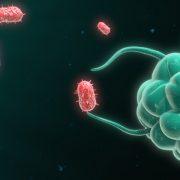The Science of Healthy Habits—Your Path to Success

Have you ever found yourself sitting in a drive-thru at your usual fast food joint…like your car drove there on autopilot? You’re confused because you’d told yourself today was the day you’d go to the salad place for lunch. How did this happen? You’ve just experienced the tremendous power habits can have over your life.
You have good intentions. You know all the rules for living a healthy lifestyle. Eat a balanced diet with lots of fruits and veggies, manage your weight, get enough sleep, take your vitamins, exercise at least 150 minutes a week, etc.
Sounds easy enough, right? Wrong. If it were easy, everyone would do it.
Yes, change can be hard. And, if putting your knowledge about living a healthy lifestyle into action sometimes feels impossible, you’re not alone. Fortunately, there’s hope. People successfully create big transformations by making small changes every day. And you can, too.
The answer may lie in the science of healthy habits. And you don’t have to start from scratch. You can use the habits you already have. Maybe even the one that drove you to that drive thru.
This is Your Brain on Habits

Your brain is lazy. Well, to put it more accurately, it has better things to do than to stay focused on all of the mundane activities you do every day. So, along come habits.
These automatic behaviors drive nearly half of your daily life. Just consider: did your routine this morning vary much from yesterday? Last week? Last year? We’re creatures of habit because it’s the most efficient way to get through the day.
Scientists don’t always agree on the exact definition of what a habit is. But broadly, a habit is any action, or sequence of actions, initiated by a cue. It can be a time of day, an event, another person, an emotional state, or a location. The cue causes a behavioral response. And if the behavior results in some kind of reward, your brain learns that the behavior is desirable.
For example:
- Cue: stumble downstairs to the kitchen after waking up
- Behavior: make and drink coffee
- Reward: feeling awake and more energized
If you continue to repeat these actions, eventually you perform them without even thinking about it. A habit loop is born. And afterward, even the perception of the cue will usually trigger the habit.
Sometimes the rewards in this habit loop can be as mundane as achieving a small goal—like getting to work by driving the same route every day. This leads to goals that are easy to repeat and likely wouldn’t be hard to break.
However, if the reward is really powerful, it can lead to a habit loop that’s harder to change. When you eat things like chocolate or cheese, or show the brain new posts on social media, your brain is rewarded with things it likes. Neurotransmitters (chemical messengers) like dopamine are released in the brain, resulting in pleasurable sensations.
Dopamine is considered a key player in helping your brain establish automatic behaviors. Because your brain likes to feel good.
If your brain doesn’t feel so great, like when you’re stressed or sad, it can drive you to perform the habit. Even if, consciously, you know it’s not good for you. Your brain knows the behavior will relieve the bad feelings—even if it’s only temporary—driving you to do the activity again and again.
The brain sends feel-good messages along pathways. And as habitual actions are repeated, those pathways are strengthened. It works like a forest trail that becomes worn more deeply into the earth as people tread the same path. Once a neural pathway for a habit is established, it becomes the default path to follow. And the pathway becomes even more fixed as the habit is repeated.
Eventually, your habits become as automatic as walking or scratching your nose. This is reflected in your biology. When habits are being created, there is activity in the decision-making areas of your brain—the prefrontal cortex and the hippocampus. Over time, as the behavior is repeated, the activation in the brain shifts to the same part of the brain responsible for moving your limbs. You’re no longer thinking actively. Instead, you’re responding with as much thought as it takes to move your arms or legs.
This is why changing habits can be challenging. You have to pick a new path to reach your desired destination.
A 3-Step Process for Changing Your Habits
You probably already have a health goal you want to achieve. Some of the most common goals are losing weight, exercising more, and eating healthier. All of those are lofty goals that may seem overwhelming. Aim for small changes that are manageable. Keep it simple by only focusing on one thing at a time. Each small success will add up to greater confidence in your ability to adopt other healthy habits. And over time, all those small changes could add up to a big transformation.
Get started by narrowing down your options to only one action that will help you successfully accomplish your goal. Then follow three key steps, recommended by Charles Duhigg, author of The Power of Habit, to create a new habit loop.
Step 1: Identify your cue
You probably already have a lot of set habits. So, one of your existing habit loops may be a good place to start incorporating the new activity on which you want to focus. If you’re working to establish a fairly simple new habit, this probably won’t require too much effort.
Perhaps you want to drink more water. Take a look at your habitual routines and identify somewhere you could add this behavior. If you drink coffee first thing every morning, that might be a logical and easy place to add a little hydration. Try placing a glass in front of the coffee maker. This will prompt you to fill it up with water as you prepare your java. Then drink it while the coffee is brewing. Keep it up for several days and voila!—new habit.
However, if you’re trying to replace a strongly embedded routine with a healthier alternative, you may need to take some time to redesign your habit.
Start with the cue.
Let’s say you need to break your Monday–Friday habit of buying and eating potato chips at your workplace cafeteria. It’s not doing your waistline any favors, and you want to replace this habit with something healthier. Potato chips reward your brain, so you probably enjoy this behavior. This could make it a tougher habit to change, and will require a slightly scientific approach.
First, take a few days to identify your cue. Because most cues are a time of day, an event, another person, an emotional state, or a location—these are the places to look. Every time the craving to treat yourself to potato chips hits, write down the following:
- Where are you?
- What time is it?
- What’s your emotional state?
- Who else is around?
- What action preceded the urge?
Do this for a few days until you see a pattern emerge. You will have uncovered what your cue is.
Step 2: Recognize the reward
Once you’ve revealed your cue, you need to figure out what’s driving the behavior. It’s time to test some rewards. Put your scientist cap back on and test theories until you determine the cause of your cravings. Take a few more days to experiment with different rewards each time your craving hits.
- Theory: I just want a break from work.
Test: Instead of going to the cafeteria, I’ll head outside for a walk. - Theory: I’m hungry or need energy.
Test: I’ll still go to the cafeteria and buy something else. (Don’t put too much pressure on yourself to make a healthier choice yet—just buy something else.) - Theory: I enjoy socializing while eating my chips in the cafeteria.
Test: I’ll go chat with friends somewhere else.
To conclude your test, immediately reflect on the experience of resisting your usual craving and substituting something else. Write down a few thoughts about your test behavior. How do you feel? What did you enjoy? What did you dislike?
About 15 minutes after writing about your experience, also note if you’re still experiencing the craving. And if so, how strong the craving is.
Test as many theories as possible. After you’re done with all of your experiments, review your notes and interpret your results to identify the real reward of your habit.
Step 3: Replace the behavior
You know the reward you’re seeking. And what’s triggering the behavior. So, how do you break the loop?
The reward and cue might be tough to change. If your cue is a time of day, you can’t exactly skip 3 p.m. in the afternoon! So, if you can’t remove or replace the cue, changing your habitual response is the place to focus your efforts. You’ll need to replace the old behavior with a new one.
You need a plan. A very specific plan. And maybe a touch of willpower.
Determine some options you could do to get the same or very similar rewards using different behaviors that better align with your goals.
In the potato-chip munching example, let’s say your long-term goal is to improve your eating. Your action of focus may be adding one serving of fruit or vegetables every day. So, you’ll need to look for healthier options that you’ll enjoy (almost) as much the potato chips. How about edamame with salt? Or an apple? Some carrots and hummus?
Choose your substitute. Write down your plan. Be as specific as possible. Include the cue and, if applicable, when and where you will do your chosen action.
Example: At 3 p.m., every day, I will go to the cafeteria and eat a snack of edamame with salt.
Every time you encounter the cue, do the action. Your routine may not be perfect. But it’s progress.
Simple Actions to Get Started Toward Healthy Habits
There are many small changes you can adopt to improve your health habits. Below are several examples to help inspire ideas.
Eating a healthier diet.
Improving how you eat is often a matter of preparation. So, one of the first habits to establish is making meal planning, grocery shopping, and meal prep an automatic part of your week. If planning a whole week’s worth of meals is too much, start by planning one meal and work your way up.
Also, as you go through your days, it’s important to try and only eat when you’re actually hungry…but not too hungry. Getting in touch with your true hunger signals is a key component of healthier eating patterns. Whereas starving yourself will often lead to bingeing. As long as your hunger is under control, it’s easier to make smarter food choices. Here are a few suggestions for simple actions that could help you start improving your daily nutrition:
- Every morning when I drink my tea, I will eat a banana.
- Every day at lunch, I will eat one serving of vegetables.
- Every evening after dinner, I will take my vitamins with a full glass of water.
- Every night before I brush my teeth, I will prepare my lunch for the next day.
Exercising at least 30 minutes, most days of the week.
Exercise is key to a long, healthy life. The secret to sustained fitness is finding an activity you enjoy. If you hate running but love a Zumba class, don’t force yourself to run every day. Instead, dance to your heart’s delight. If you’re just starting, here are a few suggestions for simple actions you can take to help establish fit habits:
- Every morning after I wake up, I will put workout clothes on and go for a 10-minute walk/do a seven-minute workout (science backs up that this works!).
- Every day after lunch I will walk around the park.
- Every Wednesday I will leave work and go straight to a yoga class at the gym.
Managing your weight.
Some research has shown that combining habit-changes with traditional weight-loss approaches can make it easier to maintain your lower weight. Addressing relationships with food and attitudes about weight and body image were also important.
When it comes to weight management, diet and exercise go hand-in-hand for best results. But you can also try some easier shifts. Research suggests that simply paying attention to what you eat or to your daily weight can help you start shifting your lifestyle habits. Or, try making a habit of replacing meals or calorie-rich beverages with better options.
- Every time I eat something, I will track it.
- Every morning after using the bathroom, I will weigh myself.
- Every day after my 30-minute lunchtime workout, I will drink a meal-replacement shake.
- Every afternoon at work, I will replace my usual soda with a flavored sparkling water.
Other areas to consider making healthy habits, if they apply to you, could be around social media usage, responsible alcohol consumption, getting more sleep, or quitting smoking. Just remember to be as specific as possible about what your cues are and how you respond to them.
Struggling to Change? The Science of Healthy Habits Says Add Emotion to Increase Motivation
What if you’re struggling against changing your habits? You understand rationally why you need to ban your old behaviors. But if your intelligent reasons to change are uninspiring, they’ll be less than motivating. Successful change requires enough desire to see it through to the end.
You can add motivation to your habit-change efforts by purposefully amping up the emotion. Emotional responses help drive learning, including learned responses like habits. So, you can harness this power by using your emotions to your benefit.
If you’re trying to break a habit, negative emotions could be your friend. Researchers found that habitual smokers who became more mindful of their experience realized the sensations weren’t very pleasurable. The taste was full of chemicals. Their breath, clothes, and surroundings stunk like cigarettes. This prompted disgust—an emotional reaction to smoking that spurred stronger motivation to change. Staying in touch with this feeling, along with practicing other mindfulness techniques like meditation, made it easier for participants to stick with their efforts at quitting.
On the flip side, positive emotions have a place in changing your habits, too. Every time you complete the goal action you’d like to make a habit, take a moment to check in with yourself. Feel how happy doing this activity makes you. Consciously decide to enjoy the action. Tap into your sense of hope for the future. These positive emotions can start to wear those habit trails more deeply into the terrain of your brain.
Try using both types of emotion while forming new healthy habits. Link your deep frustration with the aches and pains limiting your potential with unhealthy eating habits or a lack of exercise. Use that frustration to fuel your fire to change. Then, after you eat that healthy meal or complete a workout, take a moment to appreciate how good your body feels. And re-engage that feeling of deep desire to change to help refuel your motivational gas tank.
Other Science-Based Tips for Successfully Changing Habits
It’s true. In order to successfully change a habit, you may have to work at it for a while. There is a common misperception that changing habits only takes 21 days. Sure, some simple habits may change that quickly. But others can take as long as six months or more, depending on how deeply ingrained they are.
One thing is sure: the more you repeat any activity, the more permanent it will become. But researchers at University College London have found that 66 days is the average time it takes for effortful actions—like starting a regular exercise routine—to become more automatic.
How can you stay focused and inspired to change during those two months? Well, everyone is different and every habit might need a different approach. Give yourself a reality check about what motivates you. Then choose strategies that will work best for your personality.
Try some of these ideas to help you stay on track as you work to establish new healthy habits:
- Stay connected to your goals. Short-circuit your old, bad habits with a goal you’re passionate about. Focus on your goals daily. Write about them in a journal. Talk about your goals with others. Visualize the successful change of your behaviors leading to achieving your goals.
- Anticipate stress. Challenges in life are one of the biggest triggers for regressing to old, comfortable habits. Some life events—like moving to a new home—provide an opportunity to change your environmental cues and establish new routines. But you might not want to try and break those really tough habits in the middle of a stressful time. When you’re ready and able to tackle those tough habits, actively work to manage everyday stresses, so they don’t get out of hand and derail your efforts. Try daily deep breathing or yoga exercises. Get out into nature. Listen to soothing music. Create intentional moments of self-care at home.
- Track your progress and reward yourself for success. Many people find it helpful to keep a record of their progress. Try one of the habit-change tracking apps available for your smartphone. Use a spreadsheet. Or a good old notebook will do. Keep notes about how the behavior felt, so you can see it getting easier. Select a treat you can give yourself that won’t blow your goals, but will keep you motivated. And give yourself the treat for successfully completing the target behavior. Weight-management research has shown better outcomes when subjects monitor and reward themselves for successful habit changes, rather than for achieving a number on a scale.
- Get a buddy or join a group. There is strength in numbers. Not only can others help keep you accountable, they can provide support during the tough times. A report on tobacco cessation programs in Argentina found participation in group sessions had significantly greater success in quitting than toughing it out alone. You may also want to make some new friends. Surrounding yourself with people who behave how you would like to behave can help you be more successful.
- Remove the temptation. Don’t keep the cookies in the house. Ask your friend to go for a walk instead of going out for happy hour (then counting on willpower to keep you from overindulging). Find a new way to drive to work that doesn’t go by the siren-song of Starbucks. Put your smartphone in a drawer when you get home. There’s truth to the saying “out of sight, out of mind.”
Every time you have to use effort to control your behavior, it depletes your mental strength. So, make life easier. Help maintain your motivation by removing the cue that causes your compulsion wherever possible. And look for ways to increase your positive cues, like placing a bowl of fruit on the table or a bottle of water (reusable, of course) on your desk.
- Get help. If you’re using your old habit behavior as a substitute for other needs, you may need additional support. Ask yourself what you get out of your “bad” behavior. And really, truly answer. If you’re overeating because you’re constantly stressed or depressed, simply deciding on a new habit may not be enough. You might need to talk to a therapist or health-care provider for additional strategies to help address your deeper needs while you work to improve your health habits.
Finally, remember, you’re only human. It can be tough to make changes. Forgive yourself if you slip up occasionally. It’s the long-term that’s important. If you fall back into old habits once or twice, be kind to yourself. It doesn’t mean you’ve failed or that you can’t do it. Recognize that the action happened, consider why it happened, and think about how you might respond differently next time. Then remind yourself that you’re awesome, and move on. Over time, you will get it!
There’s no better time to start than now. Put the science of healthy habits to work for you. Find a small habit to focus on and get going. Before you know it, you’ll develop the skills you need to improve your healthy habits in any area of your life. And you will be empowered to live the life that you truly want.
References
Neural plasticity: 4 steps to change your brain & habits. [Internet] [accessed 11 June 2018] Available at http://www.authenticityassociates.com/neural-plasticity-4-steps-to-change-your-brain/
Chi K. 2016. Why are habits so hard to break? Duke Today [Internet] [accessed 11 June 2018] Available at https://today.duke.edu/2016/01/habits
Klika B, Jordan C. 2013. HIGH-INTENSITY CIRCUIT TRAINING USING BODY WEIGHT: Maximum Results With Minimal Investment. ACSM’s Health & Fitness Journal 17(3): 8-13.
Andrews L. 2013. Daily weighing may help manage your weight. Psychology Today [Internet] [accessed 7 June 2018] Available at https://www.psychologytoday.com/us/blog/minding-the-body/201312/daily-weighing-may-help-manage-your-weight
Public Health Nutr 15(12): 2272-9.
Lally P, van Jaarsveld CHM, Potts HWW, Wardle J. 2010. How are habits formed: modelling habit formation in the real world. Euro J Soc Psychol 40:998–1009.
Lally P, Gardner B. 2011. Promoting habit formation. Health Psyc Rev 7(sup1): S137-S158.
Wood W, Neal DT. 2007. A new look at habits and the habit-goal interface. Psychol Rev 11(4): 843-63.
Neal D, Wood W, Quinn J. 2006. Habits—a repeat performance. Curr Dir Psyc Sci 15(4): 198-167.
Is your social circle supportive? The Mayo Clinic Diet [Internet] [accessed 11 June 2018] Available at http://diet.mayoclinic.org/diet/motivate/is-your-social-circle-supportive?xid=nl_MayoClinicDiet_20160811
A Guide to Changing Habits. The Power of Habit Resources [Internet] [accessed 11 June 2018] Available at http://charlesduhigg.com/resources/















